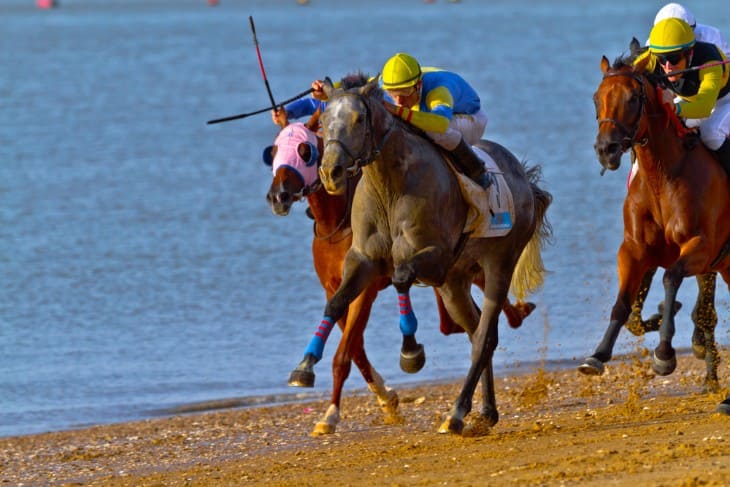- Understanding Odds and Probabilities in In-Race Betting
- Key Strategies for Successful In-Play Horse Betting
- The Role of Technology in In-Race Betting Systems
- Analysing Horse Performance Metrics for In-Play Betting
- The Impact of Weather and Track Conditions on In-Race Betting
- Comparing Traditional and In-Play Betting Approaches in Horse Racing
- Expert Tips for Novices in In-Play Horse Race Betting
- Conclusion
In the realm of horse racing, in-play betting represents a significant shift from traditional wagering methods. Its origins can be traced back to the early days of online betting, where technological advancements allowed for real-time betting during a race. Unlike the pre-race betting, where bets are placed before the event starts, in-play betting permits punters to bet on various outcomes while the race is in progress. This shift has dramatically altered the betting landscape, introducing a dynamic and interactive element to horse racing.
The evolution of in-play betting in horse racing has been heavily influenced by the advent of live streaming and advanced data analytics. Live streaming allows bettors to watch races in real-time and make informed decisions based on the performance they observe. Advanced data analytics, on the other hand, provides detailed insights into the performance of horses, jockeys, and track conditions. These technological enhancements have made in-play betting more accessible and appealing, attracting a new generation of bettors who seek a more engaging and immediate betting experience.
Understanding Odds and Probabilities in In-Race Betting
Grasping the nuances of odds and probabilities is crucial for success in in-race betting on horse races. Odds in in-play betting fluctuate more rapidly than in traditional pre-race betting, reflecting the changing circumstances of the race as it unfolds. Understanding these odds requires not only a grasp of basic betting principles but also an ability to interpret how race developments impact a horse's chances.
- Impact of Race Events: Certain events during a race, such as a horse taking the lead or showing signs of fatigue, can significantly alter the odds. Bettors need to understand how these events affect a horse's likelihood of winning.
- Probability Analysis: Successful in-play bettors often employ probability analysis to make informed decisions. This involves evaluating a horse's performance history, current form, and race conditions.
- Quick Decision Making: The dynamic nature of in-play betting requires bettors to make quick decisions. As the race progresses, odds can change rapidly, demanding a responsive approach to betting.
- Risk Assessment: Understanding the inherent risks and potential rewards is crucial. This includes knowing when to place a bet and when to refrain, based on the shifting probabilities during the race.
Mastering the art of interpreting odds and probabilities in in-race betting can significantly enhance the chances of success. It involves a mix of analytical skills, quick thinking, and an in-depth understanding of horse racing dynamics.
Key Strategies for Successful In-Play Horse Betting
Successful in-play horse betting is not just about luck; it involves strategic planning and an understanding of the racing dynamics. One of the key strategies is studying in-race form. This involves analyzing the horse's performance in real-time, considering factors like pace, positioning, and the jockey's decisions. Bettors who excel in in-play betting often have an acute sense of how a race is unfolding and can predict changes in momentum or strategy that may affect the outcome.
Another vital strategy is bankroll management. Given the fast-paced and unpredictable nature of in-play betting, it's crucial to have a well-defined budget and stick to it. This helps in mitigating losses during a string of unfavourable outcomes and ensures that betting remains a sustainable activity. Experienced bettors often advise against chasing losses in in-play betting, as the rapid pace can lead to hasty and ill-considered wagers.

The Role of Technology in In-Race Betting Systems
Technology plays a pivotal role in modern in-race betting systems, transforming how bettors interact with the sport. Advanced software and algorithms are now used to provide real-time data and analytics, which are essential for making informed betting decisions. These systems can track and analyze numerous variables, including a horse's speed, stride length, and even its heart rate, offering a detailed picture of its performance and potential.
The integration of mobile technology has also revolutionised in-race betting. Bettors can now place wagers from anywhere, using smartphones or tablets, and stay updated with live race feeds and betting odds. This accessibility has broadened the appeal of in-play betting, attracting a more diverse range of participants. As technology continues to evolve, it's likely that these betting systems will become even more sophisticated, further enhancing the in-play betting experience.
Analysing Horse Performance Metrics for In-Play Betting
In the context of in-play betting on horse racing, analysing performance metrics is critical. This analysis involves a detailed examination of various aspects of a horse's form and behaviour during the race. Studying in-race form is not just about looking at past performance, but also interpreting how a horse is performing in the current race. Bettors often focus on metrics like speed variations, the horse's response to different track conditions, and the efficiency of its movements.
Key performance metrics to consider include:
- Speed and Pace: Monitoring how the horse maintains or changes its speed and pace during different race segments.
- Recovery and Stamina: Assessing the horse's ability to recover from exertion and maintain stamina throughout the race.
- Jockey's Strategy: Evaluating the decisions made by the jockey during the race, such as positioning and timing of sprints.
Understanding these metrics can provide bettors with a significant edge in making more informed betting decisions. This requires not only access to real-time data but also the ability to interpret and apply this information effectively during the rapidly changing circumstances of a race.
The role of psychological factors in making in-play betting decisions is often underestimated. Betting, particularly in the fast-paced environment of in-race wagering, involves a high degree of emotional and psychological engagement. Bettors must manage their emotions, particularly under the pressure of time-sensitive decisions, to avoid impulsive and irrational bets. Developing a mindset that balances excitement with rational analysis is key.
Cognitive biases can also significantly impact betting decisions. Confirmation bias, for instance, can lead bettors to overvalue information that supports their preconceived notions about a horse's chances. Similarly, the gambler's fallacy can mislead bettors into believing that past events can predict future outcomes in a random process like horse racing. Being aware of these psychological factors and actively working to mitigate their influence can greatly enhance the effectiveness of in-play betting strategies.
The Impact of Weather and Track Conditions on In-Race Betting
Weather and track conditions are pivotal factors in horse racing, significantly impacting the outcome of races and, consequently, in-play betting decisions. Studying in-race form involves considering how these external conditions affect each horse's performance. Various weather conditions, such as rain, wind, or extreme temperatures, can alter the race dynamics, making some horses more or less favourable depending on their previous performances under similar conditions.
Key considerations include:
- Track Surface: Different weather conditions can change the track surface, influencing a horse's grip and speed. For instance, a wet track may favour horses that have previously performed well in similar conditions.
- Visibility: Fog, rain, or bright sunlight can affect visibility for jockeys and horses, potentially leading to unexpected race outcomes.
- Horse Adaptability: Some horses may be more adaptable to certain weather conditions than others. This adaptability can be a crucial factor in deciding which horse to bet on during a race.
Bettors who successfully incorporate these factors into their in-play betting strategies can gain a significant edge. It requires not only access to up-to-date weather information but also an understanding of how different horses have historically responded to various environmental conditions.

Comparing Traditional and In-Play Betting Approaches in Horse Racing
Comparing traditional and in-play betting approaches in horse racing reveals distinct differences in strategy, risk, and engagement. Traditional betting involves placing wagers before the race begins, based on pre-race form, historical performance, and fixed odds. This approach requires extensive research and analysis beforehand but offers a more static and considered betting experience.
In contrast, in-play betting is dynamic, with odds fluctuating in real-time as the race unfolds. This form of betting demands quick thinking and the ability to make decisions based on live race conditions. It offers a more interactive and immersive experience, but also carries higher risks due to its fast-paced nature. Crucial to both methods is studying in-race form, but the application of this knowledge differs significantly between the two. While traditional betting allows for more deliberative analysis, in-play betting necessitates rapid assessment and adaptability. Each approach appeals to different types of bettors and offers unique challenges and rewards.
Expert Tips for Novices in In-Play Horse Race Betting
For novices in in-play horse race betting, there are several expert tips that can significantly enhance the chances of success. First and foremost, understanding the basics of horse racing and studying in-race form is essential. This involves analysing how horses perform under different conditions and how they respond to the dynamics of the race. Gaining this knowledge requires time and effort but is crucial for making informed betting decisions.
Important tips for beginners include:
- Start with Small Bets: Initially, it's wise to place smaller bets to minimize potential losses as you learn.
- Focus on a Few Races: Instead of betting on multiple races, concentrate on a few to better understand the variables involved.
- Use Reliable Information Sources: Access to accurate and timely information is key. Utilize reputable sources for race data and betting odds.
- Learn from Experience: Keep a record of your bets and outcomes to identify patterns and areas for improvement.
By following these tips and consistently applying them, novices can gradually build their skills and confidence in in-play horse race betting.
Conclusion
The ability to bet on live races and respond to real-time developments has transformed the landscape of horse race wagering. As this form of betting becomes more accessible and sophisticated, it is likely to attract a broader audience, blending the excitement of the sport with the thrill of live betting.
The key to success in this evolving environment remains a thorough understanding of the intricacies of horse racing and studying in-race form. As bettors become more knowledgeable and skilled, and as the industry adapts to changing technologies and regulations, in-play betting is poised to become an even more integral part of horse racing culture. This dynamic and interactive form of betting not only enhances the spectator's experience but also opens up new opportunities for strategic and profitable betting.
For more information:








